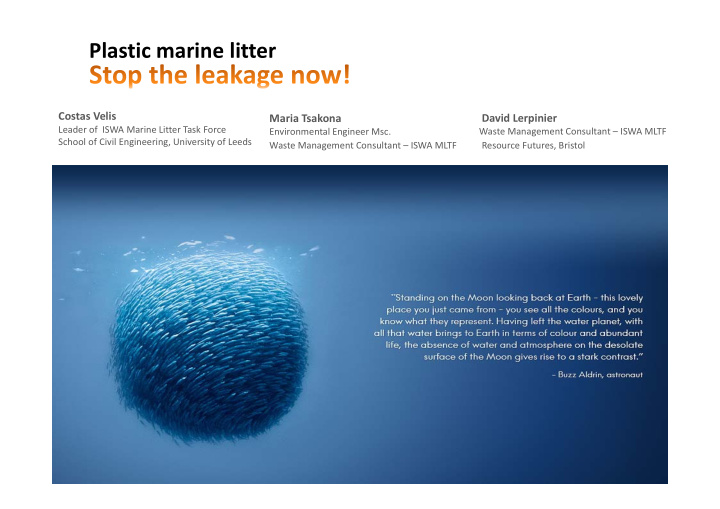



Plastic marine litter Costas Velis David Lerpinier Maria Tsakona Leader of ISWA Marine Litter Task Force Environmental Engineer Msc. Waste Management Consultant – ISWA MLTF School of Civil Engineering, University of Leeds Waste Management Consultant – ISWA MLTF Resource Futures, Bristol
Define the role of waste & resource management sector to tackle marine litter http://marinelitter.iswa.org/
A GLOBAL CHALLENGE Destroying ecosystems & marine-based economic sectors For the 21 economies of the Asia- Pacific rim marine debris-related damage to marine industries costs US$1.26bn per annum (Greyer, et al. 2017)
Sources, Pathways, Transformation & Fates
Key land ‐ based sources of Plastic Marine Litter In the UK, fly-tipping is a worsening cause of environmental damage that has cost for local authorities in Uncontrolled 2015/16 £49.8 million (DEFRA, 2017) Dumping Generally global dumpsites receive roughly 40% of the world’s waste and they serve about 3-4 billion people (Mavropoulos et al., 2016) 38 of the world’s biggest dumpsites located close to the sea (D-Waste, 2014) Littering Around 2 billion people do not share any Tourism, major public events, waste collection services. busy areas of cities (D-Waste, 2014)
Industries Agriculture 86% of the Danube River’s plastic Extensive use of polyethylene films – load originates from the activities of 80% of the agricultural plastic waste plastic manufacturing and processing companies near the banks Waste Management More than 1 million tons of mulch Escape of plastics from mis-managed film is used worldwide every year waste management activities – low- (Kasirajan et al, 2012) tech, uncontrolled treatment plants Application of sewage sludge and compost with plastic impurities in agriculture Fisheries and shipping in waterways River-fish related items from commercial and recreational fishermen (e.g. nets and fishing lines)
Citarum River, Indonesia The PATHWAYS Citarum has been called the world's most polluted river. Around 5 million people live in the river's basin Rivers Between 1.2 and 2.4 million tonnes of plastic litter currently flows from the world’s rivers into the oceans every year (Lebreton et al., 2017)
PATHWAYS Drainage systems and flooding events Plastic waste disposed on sidewalks and streets and in gutters flows directly into streams and rivers during rain events. Sewers Overflow During heavy rainfall episodes untreated wastewater can find its way, via combined sewer outfall into rivers/sea. In the River Thames, there are 57 ‘combined sewer overflow’ sites which overflow approximately 60 times a year, resulting in Wind blown litter approximately 39 million tonnes of raw sewage entering the Atmospheric Inputs watercourse
MACROPLASTICS TRANSFORM INTO MICROPLASTICS
Sinks Plastic litter has four main sinks: 1) sink and buried in the sediments, 2) trapped on riverside vegetation and degraded on river banks; or 3) transported to the estuary and then deposited on beach 4) flow in the ocean
GLOBAL SYSTEMIC FAILURES 1 2 MATERIALS AND INSUFFICIENT INFRASTRUCTURE CONSUMPTION 3 4 PUSH MARKETS KNOWLEDGE GAPS ON TECHNOECONOMIC SUSTAINABILITY ASPECTS OF PLASTICS LIFE CYCLE
Marine litter and the Sustainable Development Goals (SDG) ‐ UN. One of SDG 14’s component targets is to prevent and significantly reduce marine debris. This cannot be achieved without implementing effective waste and resource management for all, which is also a key requirement for achieving SDG 11 (creating sustainable cities and communities) and SDG 12 (achieving responsible consumption and production).
DIFFERENT INTERVENTIONS - DIFFERENT TIMESCALES
Actions ‐ Now! Investing in effective waste management in low ‐ income countries is likely to represent the most cost ‐ effective and immediately practicable solution to reducing marine litter in the short term. • Prevent uncontrolled dumping by providing collection services for all • Prevent littering and stop fly ‐ tipping • Close dumpsites and provide waste treatment and disposal facilities for all communities • Work with the maritime sector to establish effective take ‐ back systems for recovering waste and recyclable materials from the fishing, shipping and touristic activities.
Mid ‐ Term Actions • Capturing and enhancing the value of waste plastic ‐ developing effective collection systems that maximise and stabilise the value of secondary plastics • Properly functioning markets for recycled plastics. ‐ Address issues associated with global supply chains and social ‐ environmental justice ‐ Better data and information sharing on waste and recycled waste at all stages of their use and end ‐ of ‐ life cycle.
Long ‐ Term Actions A step ‐ change from the linear use of plastics to a sustainable and proven circular and cascading system is needed ‐ Sustainable and effective circularity ‐ Clean material cycles
Innovate and invent at the materials, design and processing level ‐ design products for recyclability and value retention after the use phase ‐ replace plastics with new materials (bio ‐ plastics)
A radical shift from today’s practices, based on a cross ‐ sector and intra ‐ disciplinary collaboration of the industries and the scientific sector.
Stop the leakage now! maria.tsakona@qadvisors.gr
Recommend
More recommend